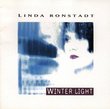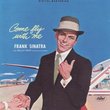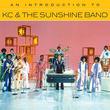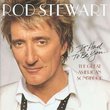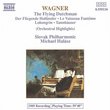| All Artists: Samuel Barber, Francis Poulenc, Camille Saint-Saens, Christoph Eschenbach, Philadelphia Orchestra, Olivier Latry Title: Saint-Sa�ns: Symphony No. 3; Poulenc: Organ Concerto; Barber: Toccata Festiva Members Wishing: 0 Total Copies: 0 Label: Ondine Original Release Date: 1/1/2007 Re-Release Date: 2/13/2007 Album Type: Hybrid SACD - DSD Genre: Classical Styles: Forms & Genres, Concertos, Symphonies, Symphonies Number of Discs: 1 SwapaCD Credits: 1 UPC: 761195109458 |
Search - Samuel Barber, Francis Poulenc, Camille Saint-Saens :: Saint-Sa�ns: Symphony No. 3; Poulenc: Organ Concerto; Barber: Toccata Festiva
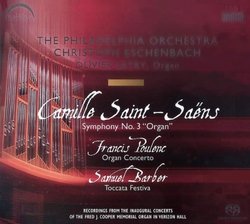 | Samuel Barber, Francis Poulenc, Camille Saint-Saens Saint-Sa�ns: Symphony No. 3; Poulenc: Organ Concerto; Barber: Toccata Festiva Genre: Classical
This disc is drawn from the concerts inaugurating the new organ in Philadelphia's concert hall, a fine instrument well-captured by the engineers. But along with the sense of occasion, organist Olivier Latry and the orchest... more » |
Larger Image |
CD DetailsSynopsis
Amazon.com This disc is drawn from the concerts inaugurating the new organ in Philadelphia's concert hall, a fine instrument well-captured by the engineers. But along with the sense of occasion, organist Olivier Latry and the orchestra deliver stunning playing of a stimulating program. Barber's celebratory overture is an apt opener, full of color and sparkle. The Poulenc is especially notable for the intensity soloist and the orchestra bring to one of the finest modern concertos in the repertory. Saint-Saëns' Symphony is almost on the same level, slightly marred by a sluggish slow movement but with plenty of excitement elsewhere. Perhaps the most impressive aspect of this disc is the playing of the orchestra, full of life and vitality. The sheer sound of the Philadelphia strings is captivating enough, but the fetching wind solo turns and section work remind us of the continuing greatness of this ensemble. Latry too, is outstanding in the Barber and Poulenc works and an incisive presence in the Saint-Saëns. -- Dan Davis Similarly Requested CDs
|
CD ReviewsKiller organ/orchestra disc B. Guerrero | 02/16/2007 (5 out of 5 stars) "If you want an organ and orchestra, sound-spectacular, look no further than here. If, like me, you listen to your newest Saint-Saen "Organ" symphony by jumping to the start of the fourth movement; well, let me tell you, the Fred J. Cooper Memorial Organ just about knocked me on my can! It has a huge sound, but - as David Hurwitz mentioned in his less than thoroughly enthused review - there's no hint of steeliness in the tone of this monster; which is my main complaint about the large organs that have been installed at S.F.'s Davies Hall, and Dallas' Meyerson Hall. This one simply tops them. Let's start at the beginning. I love the Barber "Toccata Festiva". If a recording of it existed with Ormandy, I've never heard it, and don't recall ever having seen it. No matter - it couldn't possibly be better than this one. Think of one of Barber's "Essay For Orchestra" pieces (there are three of them), crossed with the "Wild Hunt" scene from Schoenberg's "Gurrelieder"; then add a giant organ than moves in and out of the foreground - that might give you some idea what this piece sounds like. All that's missing is Schoenberg's rattling of the chains. At 16 minutes, it's a perfect organ inaugeration type work. But what I will admit to you, is that have a very poor basis of comparison on the Poulenc organ concerto. It's not a work that I've warmed to over the years (love the harpsichord concerto: Concert Champetre). That being the case, I can imagine that the Eschenbach/Latry partnership is a bit less nimble on its feet than some of its highly distinguished predecessors, such as Munch/Boston. Just don't rely on me to do the comparison because I just don't care enough to bother at this point. But neither did I find the performance to be so much of a deterrent, that I was just dieing to get to the Saint-Saens. In fact, I was rather enjoying the bit thicker than usual textures - not something one would want to readily boast about liking in this day and age of "composer's intentions", and all that good stuff. And what of the Saint-Saens? Well, Dave Hurwitz IS correct in pointing out Eschenbach's idiosyncratic conducting in the S-S. Yes, the poco adagio is about a minute and a half slower than usual, but it didn't bother me in the least bit. By way of comparison, why is it OK for Eschenbach to expand the slow movement of Mahler's 6th symphony out to 18 minutes - marked andante moderato, by the way - but it's such a problem for the poco adagio to be a bit less "poco"; more adagio? Some of the measures actually have a fair amount of arpeggio type noodling going on; so that they stay busy sounding at Eschenbach's slower tempo. I will, on the other hand, point out that his scherzo is so fast, that the sixteenth note articulations get a bit blurred. However, it's nice to hear those ridiculous sounding afterbeat measures - located just a few bars after the movement's initial statement - go by a bit quicker than usual. It might all be a tad frantic sounding, but it IS exciting. Then comes the organ roar from hell - heaven, really. Eschenbach chooses a rather stately tempo that perfectly matches the thick, powerful, sonorous textures that EVERYONE conures up here. I like how the two pianos are balanced: not too close, but not TOO distant either. The combined organ and brass make a sound that has to be heard to be believed. But this also has some of the best cymbal playing I've heard on a CD in a long, long time. Unison cymbal/bass drum strokes make their proper, "knock you out of your chair" effect (imagine what Mahler 2 is going to sound like in Philly!). The ending is spectacular beyond belief. So, there you have it. If you want your Saint-Saens "organ" symphony to sound more like French Beethoven accompanied by an organ, you may want to just stick with what you already have. But, if you're more like me - an unabshed lover of Tchaikovsky's 1812 Overture (with chorus, canons, bells - everything) - and feel that the full potential of the Saint-Saens has never been fully tapped into on recordings, then you may very well enjoy owning this one as well. I enjoy it for the Barber; the Saint-Saens; the Fred J. Cooper Memorial Organ, and the outrageous playing and sonorities of the Philadelphia Orchestra. I'm happy to say that I don't see this disc as being in any way, a regression in the ongoing Philadelphia/Eschenbach/Ondine series. Far from it." Realistic sound, but some musical concerns... Orgelbear | 03/23/2007 (3 out of 5 stars) "I attended the first of the three Verizon Hall organ dedicatory concerts in May 2006 from which this program was taken. Ondine's 5.0 recording very closely matches my aural memory of the evening. The orchestra sound is well focused if a little distant, as if it had trouble getting off the stage out into the house. On the other hand, the organ blossoms in the space, engaging the entire hall. The Dobson organ--in real life and on disc--has seemingly unlimited power yet, paradoxically, an elegant and restrained tonal quality that never tires the ear. The Dobson has a more subtle palette than, say, the Meyerson Fisk in Dallas, which is perhaps why even full organ has absolutely no stridency. Recorded balances between organ and orchestra are realistic. If you are interested in this disc as a sound demonstration disc, an example of the Dobson, or a souvenir of a festive occasion, ignore the header and consider this a five-star recommendation. The performances, unfortunately, are another matter. The best news first...Latry and company turn in an excellent Barber "Toccata Festiva". This is a muscular performance that doesn't shy away from the work's darker side. Unavailable for many years on CD, there are now quite a number of very good recordings of the Toccata. This one is first-rate. Perhaps only Ormandy/Biggs (on the 1960s vintage Aeolian-Skinner for which Barber wrote the work) have been as successful as Eschenbach/Latry at getting to the substance beneath the Toccata's celebratory flourishes. Unfortunately, the Poulenc is simply not a contender. There is a slackness to the performance, enhanced by some rather fussy phrasing that defuses the work's cumulative effect. Worse, there is no sense of humor in evidence. The Watteau-esque pastoral sections fall flat, and the flip gallop that should make the listener want to get up and do the can-can only sounds frantic. Shaw/Murray (Telarc) are the most successful at pulling together the work's bipolar religious seriousness and campy dance hall qualities into a tragic masterpiece. The aging Angel recording with Duruflé, who played the work's premiere, is still a fine musical experience with historical interest. And, for those who require bleeding-edge SACD surround sound, Hill/Weir (Linn Records) provide a blazingly urgent performance. The Saint-Saëns Symphony No. 3 receives a generally OK reading, although the Poco adagio loses some energy as it goes along (even unusually slow tempos can have pace and tension) and Eschenbach takes the scherzo at such a fast clip that even the Philadelphians have a hard time keeping details clean and unblurred. On the whole, it's a good listen. Still, I would recommend other recordings--e.g., Nézet-Séguin (in excellent SACD surround sound), Maazel, Munch, or Paray, depending on my mood--before this one. The disc is generously filled, with almost 80 minutes of music. It's too bad there was no room for the fourth piece on the concert program, a newly commissioned work by Gerald Levinson. Maybe Ondine will have a place for it on a later SACD. Organ-and-orchestra aficionados (and maybe Barber fans) will definitely want this disc. Other listeners might want to consider alternatives. " Concrete Evidence Eschenbach Should Stay In Philadelphia Darin Tysdal | Bloomington, MN 55420 | 03/10/2007 (5 out of 5 stars) "After I heard this CD, I thought, why is Eschenbach being forced out of Philadelphia? This is ample proof that there will be a major loss. This concert must have been absolutely spectacular in the hall. My favorite is the Barber Toccata Festiva. This piece is very lucky on CD. It was commissioned by one of Barber's most infulential patrons, Mary Louise Curts Bok for the new organ dedication. So this work is a natural for this concert which was for the dedication of the new organ at Verizon Hall. Previous recordings have been stellar: Biggs/Ormandy (on a still-sounding wonderfully Sony CD), Schraeder/Kalmar (on an unmissable Cedille CD dedicating Orchestra Hall Chicago's new organ),. The Trotter/Alsop recording was promising considering her other stellar Barber recordings, but that one just didn't get off the ground. The Schmidt/Wildner recording on Audite is also quite fine, but gear shifts hinder it's effectiveness for me (this also includes the Saint Saens 3rd in a rather slow-ish recording.) Here, everything is right-and the balance between organ and orchestra is stellar! The end of the work is fantastic with the joyous applause at the end. The Poulenc is a little slow perhaps, slower than my comparison recording of Marie-Claire Alain/Conlon on Erato. The Saint-Saens also suffers from a little budging of tempo here and there but does not distort the flow of the work although Eschenbach allows for a huge slowdown right before the end of the piece-it says "Pesante" there, not "Molto Allargando". Despite my caveats, this cd is mighty impressive and should be testimony to Eschenbach, the Philly Orchestra, Ondine for their superlative sonics, and the Organist Latry and the wonderful instrument!!"
|

 Track Listings (12) - Disc #1
Track Listings (12) - Disc #1
